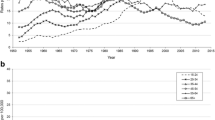Abstract
OBJECTIVE: Suicide rates in Quebec over the second half of the 20th century show a wide range of variation depending on age and time period. However, few studies have verified the presence of a cohort effect affecting trends in Quebec suicide rates. This study is designed to evaluate the potential effects of age, period and cohort (APC) on trends in suicide between 1950 and 2009 in Quebec.
METHOD: For these APC analyses, we used a multiphase approach combining a graphical inspection followed by an analysis that isolates the cohort effect from age and period effects (linear regression of the residuals from a median polish of the rates).
RESULTS: The graphical inspection of trends in rates points to combined effects of age, period and cohort among both men and women. However, the median polish analysis attributes primary importance to period effects, followed by age effects, but also shows weak cohort effects that are significant only among men born between 1950 and 1979.
CONCLUSION: The variation in Quebec suicide rates appears to be primarily a reflection of period, age and, to a lesser degree, birth cohort. Thus, in addition to sex, selection of risk groups should be based more on age and time period than on birth cohort.
Résumé
Objectif: Au Québec, le taux de suicide a connu de fortes variations au cours de la seconde moitié du XX siècle, mais très peu d’études ont vérifié la présence d’un effet de cohorte. Cette étude vise à estimer les effets potentiels d’âge, de période ou de cohorte (APC) dans l’évolution des suicides au Québec entre 1950 et 2009.
MÉTHODE: Une approche multiphase combinant une analyse graphique suivie d’une approche statistique permettant d’isoler l’effet de cohorte des effets d’âge et de période a été utilisée pour effectuer ces analyses APC (régression des résidus obtenus par polissage des taux sur médiane).
RÉSULTATS: L’analyse graphique de l’évolution des taux laisse entrevoir des effets combinés d’âge, de période et de cohorte tant chez les hommes que chez les femmes. Toutefois, l’analyse de polissage sur médiane permet d’identifier d’abord des effets de période, puis d’âge et aussi des effets de cohorte faibles, significatifs uniquement chez les hommes nés entre 1950 et 1979.
CONCLUSION: La variation des taux de suicide au Québec serait principalement associée à la période temporelle et l’âge et, dans une moindre mesure, à la cohorte de naissances. En plus du sexe, le choix de groupe à risque devrait davantage reposer sur l’âge et la période temporelle plutôt que la cohorte de naissance.
Similar content being viewed by others
References
Statistics Canada. CANSIM Tableau 102–0552 — Décès et taux de mortalité, selon certains groupes de causes et le sexe, Canada, provinces et territoires, annuel; Available at: http://www40.statcan.gc.ca/l02/cst01/health30a-fra.htm (Accessed March 7, 2012).
Institut de la Statistique du Québec. Le bilan démographique du Québec, édition 2011. Québec, QC: Institut de la statistique du Québec, 2011;147.
Beaupré M, St-Laurent D. Deux causes de décès: le cancer et le suicide. In: D’une génération à l’autre: évolution des conditions de vie, B.S.Q. Québec: Les Publications du Québec, 1998;47–81.
Shah A. The relationship between suicide rates and age: An analysis of multinational data from the World Health Organization. Int Psychogeriatr 2007;19(6):1141–52.
Clayton D, Schifflers E. Models for temporal variation in cancer rates. I: Ageperiod and age-cohort models. Stat Med 1987;6(4):449–67.
Langley J, Samaranayaka A, Davie G, Campbell, AJ. Age, cohort and period effects on hip fracture incidence: Analysis and predictions from New Zealand data 1974–2007. Osteoporos Int 2011;22(1):105–11.
Reed J, Camus J, Last, JM. Suicide in Canada: Birth-cohort analysis. Can J Public Health 1985;76(1):43–47.
Keyes KM, Li G. A multiphase method for estimating cohort effects in ageperiod contingency table data. Ann Epidemiol 2010;20(10):779–85.
Holford, TR. Temporal factors in public health surveillance: Sorting out age, period, and cohort effects. In: Brookmeyer R, Stroup DF (Eds.), Monitoring the Health of Populations. New York, NY: Oxford, 2004;99–126.
Charron, MF. Le suicide au Québec. Une analyse statistique. Québec: Ministère des Affaires Sociales, 1983;221.
Barnes RA, Ennis J, Schober R. Cohort analysis of Ontario suicide rates, 1877–1976. Can J Psychiatry 1986;31(3):208–13.
Mao Y, Hasselback P, Davies JW, Nichol R, Wigle, DT. Suicide in Canada: An epidemiological assessment. Can J Public Health 1990;81(4):324–28.
Keyes KM, Li G. Age-period-cohort modeling. In: Li G, Baker SP (Eds.), Injury Research Theory, Methods, and Approaches. New York: Springer, 2012;409–26.
Keyes KM, Utz RL, Robinson W, Li G. What is a cohort effect? Comparison of three statistical methods for modeling cohort effects in obesity prevalence in the United States, 1971–2006. Soc Sci Med 2010;70(7):1100–8.
Gagné M, St-Laurent D. La mortalité par suicide au Québec: tendances et données récentes — 1981 à 2007. Québec: INSPQ, 2009;19.
Morrell S, Page A, Taylor R. Birth cohort effects in New South Wales suicide, 1865–1998. Acta Psychiatr Scand 2002;106(5):365–72.
Odagiri Y, Uchida H, Nakano M. Gender differences in age, period, and birthcohort effect on suicide mortality rate in Japan 1985–2006. Asia Pac J Public Health 2009;20(10):1–7.
Gagné M, Robitaille Y, Hamel D, St-Laurent D. Firearms regulation and declining rates of male suicide in Quebec. Inj Prev 2010;16(4):247–53.
Hanigan IC, Butler CD, Kokic PN, Hutchinson, MF. Suicide and drought in New South Wales, Australia, 1970–2007. Proc Natl Acad Sci U S A 2012;109(35):13950–55.
Snowdon J, Hunt, GE. Age, period and cohort effects on suicide rates in Australia, 1919–1999. Acta Psychiatr Scand 2002;105(4):265–70.
Hawton K, van Heeringen K. Suicide. Lancet 2009;373(9672):1372–81.
Biddle L, Brock A, Brookes ST, Gunnell D. Suicide rates in young men in England and Wales in the 21st century: Time trend study. BMJ 2008;336(7643):539–42.
Hall WD, Mant A, Mitchell PB, Rendle VA, Hickie IB, McManus P. Association between antidepressant prescribing and suicide in Australia, 1991–2000: Trend analysis. BMJ 2003;326(7397):1008.
Rockett IRH, Kapusta ND, Bhandari R. Suicide misclassification in an international context: Revisitation and update. Suicidology Online 2011;2:48–61.
Värnik P, Sisask M, Värnik A, Laido Z, Meise U, Ibelshäuser A, et al. Suicide registration in eight European countries: A qualitative analysis of procedures and practices. Forensic Sci Int 2010;202(1–3):86–92.
Tollefsen IM, Hem E, Ekeberg O. The reliability of suicide statistics: A systematic review. BMC Psychiatry 2012;12(1):9.
Aoba A, Péquinot F, Camelin L, Jougla E. Évaluation de la qualité et amélioration de la connaissance des données de mortalité par suicide en France métropolitaine, 2006. Bulletin épidémiologique hebdomadaire 2011;47–48:498-501.
St-Laurent D, Bouchard M. L’épidémiologie du suicide au Québec: que savons-nous de la situation récente? Québec: INSPQ, 2004;23.
Geran L, Tully P, Wood P, Thomas B. Comparability of ICD-10 and ICD-9 for Mortality Statistics in Canada. Ottawa: Statistics Canada, 2005;61.
Author information
Authors and Affiliations
Corresponding author
Additional information
Conflict of Interest: None to declare.
Rights and permissions
About this article
Cite this article
Légaré, G., Hamel, D. An Age-Period-Cohort Approach to Analyzing Trends in Suicide in Quebec Between 1950 and 2009. Can J Public Health 104, e118–e123 (2013). https://doi.org/10.1007/BF03405674
Received:
Accepted:
Published:
Issue Date:
DOI: https://doi.org/10.1007/BF03405674




